Leading Learning and Change: Developing an Intervention Plan
VerifiedAdded on 2022/10/15
|14
|4185
|251
Report
AI Summary
This report presents a comprehensive leadership intervention plan designed to manage and implement change within a business setting. It begins by identifying the adoption of situational leadership as the preferred approach, emphasizing its adaptability to evolving external environments and i...
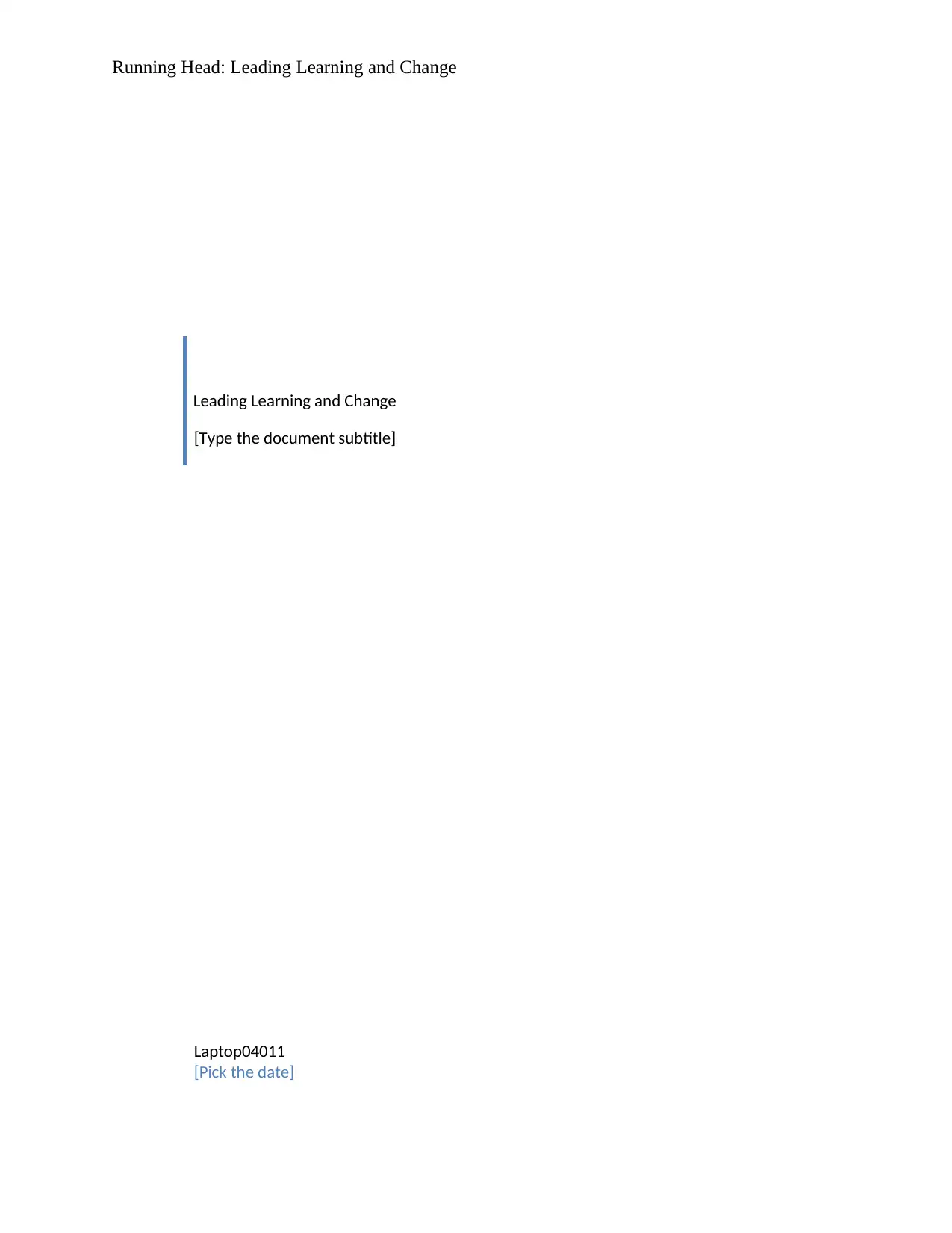
Running Head: Leading Learning and Change
Leading Learning and Change
[Type the document subtitle]
Laptop04011
[Pick the date]
Leading Learning and Change
[Type the document subtitle]
Laptop04011
[Pick the date]
Paraphrase This Document
Need a fresh take? Get an instant paraphrase of this document with our AI Paraphraser
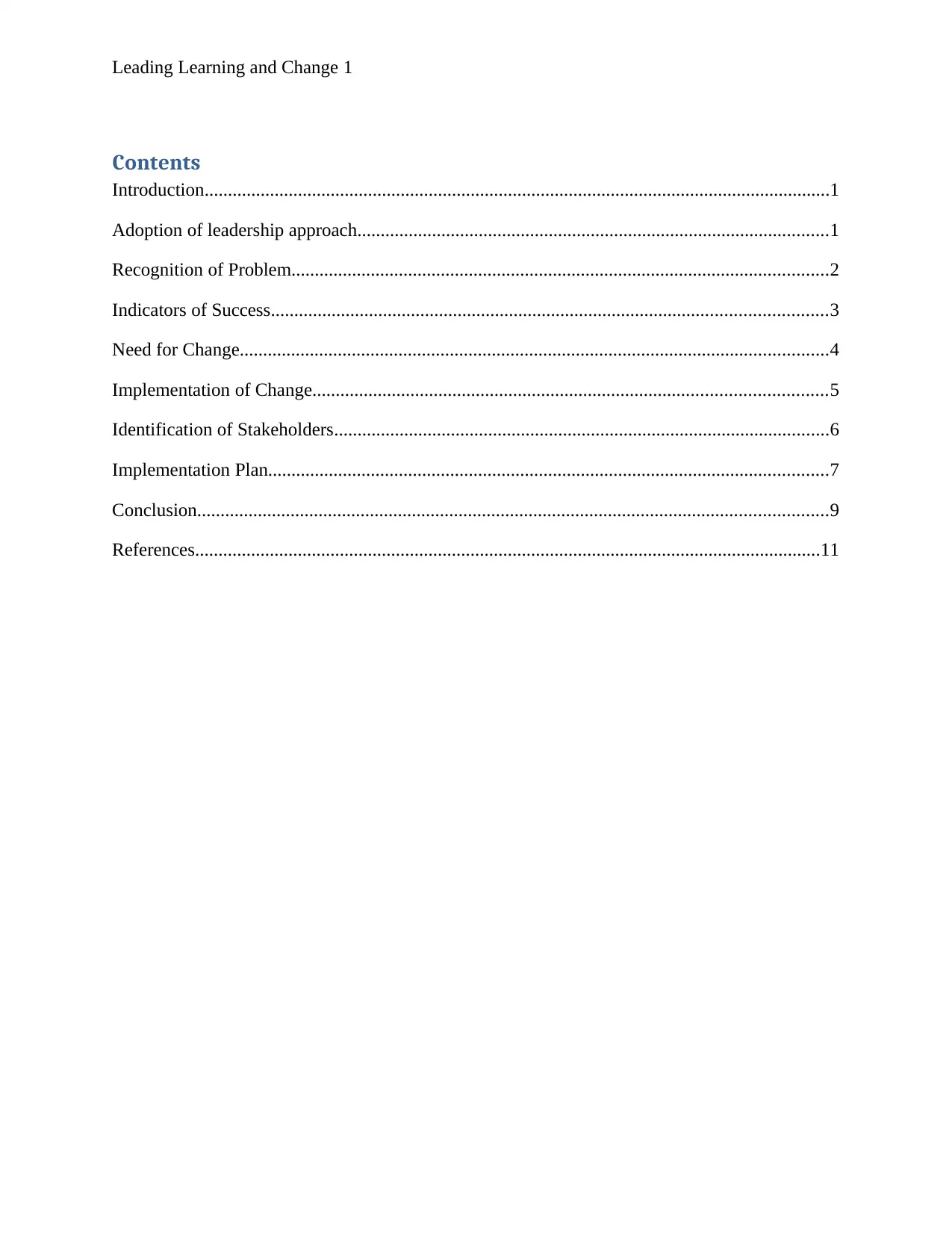
Leading Learning and Change 1
Contents
Introduction......................................................................................................................................1
Adoption of leadership approach.....................................................................................................1
Recognition of Problem...................................................................................................................2
Indicators of Success.......................................................................................................................3
Need for Change..............................................................................................................................4
Implementation of Change..............................................................................................................5
Identification of Stakeholders..........................................................................................................6
Implementation Plan........................................................................................................................7
Conclusion.......................................................................................................................................9
References......................................................................................................................................11
Contents
Introduction......................................................................................................................................1
Adoption of leadership approach.....................................................................................................1
Recognition of Problem...................................................................................................................2
Indicators of Success.......................................................................................................................3
Need for Change..............................................................................................................................4
Implementation of Change..............................................................................................................5
Identification of Stakeholders..........................................................................................................6
Implementation Plan........................................................................................................................7
Conclusion.......................................................................................................................................9
References......................................................................................................................................11
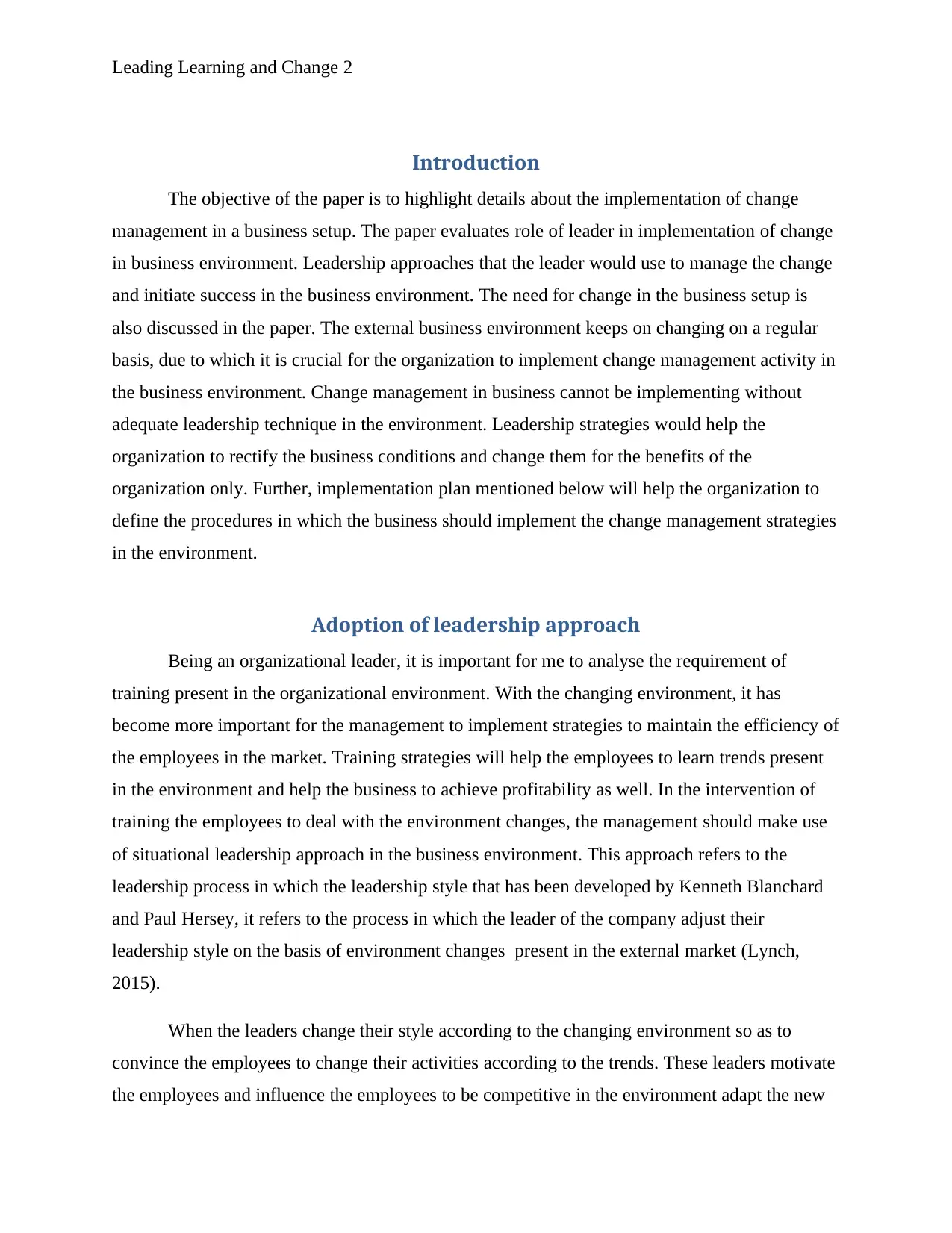
Leading Learning and Change 2
Introduction
The objective of the paper is to highlight details about the implementation of change
management in a business setup. The paper evaluates role of leader in implementation of change
in business environment. Leadership approaches that the leader would use to manage the change
and initiate success in the business environment. The need for change in the business setup is
also discussed in the paper. The external business environment keeps on changing on a regular
basis, due to which it is crucial for the organization to implement change management activity in
the business environment. Change management in business cannot be implementing without
adequate leadership technique in the environment. Leadership strategies would help the
organization to rectify the business conditions and change them for the benefits of the
organization only. Further, implementation plan mentioned below will help the organization to
define the procedures in which the business should implement the change management strategies
in the environment.
Adoption of leadership approach
Being an organizational leader, it is important for me to analyse the requirement of
training present in the organizational environment. With the changing environment, it has
become more important for the management to implement strategies to maintain the efficiency of
the employees in the market. Training strategies will help the employees to learn trends present
in the environment and help the business to achieve profitability as well. In the intervention of
training the employees to deal with the environment changes, the management should make use
of situational leadership approach in the business environment. This approach refers to the
leadership process in which the leadership style that has been developed by Kenneth Blanchard
and Paul Hersey, it refers to the process in which the leader of the company adjust their
leadership style on the basis of environment changes present in the external market (Lynch,
2015).
When the leaders change their style according to the changing environment so as to
convince the employees to change their activities according to the trends. These leaders motivate
the employees and influence the employees to be competitive in the environment adapt the new
Introduction
The objective of the paper is to highlight details about the implementation of change
management in a business setup. The paper evaluates role of leader in implementation of change
in business environment. Leadership approaches that the leader would use to manage the change
and initiate success in the business environment. The need for change in the business setup is
also discussed in the paper. The external business environment keeps on changing on a regular
basis, due to which it is crucial for the organization to implement change management activity in
the business environment. Change management in business cannot be implementing without
adequate leadership technique in the environment. Leadership strategies would help the
organization to rectify the business conditions and change them for the benefits of the
organization only. Further, implementation plan mentioned below will help the organization to
define the procedures in which the business should implement the change management strategies
in the environment.
Adoption of leadership approach
Being an organizational leader, it is important for me to analyse the requirement of
training present in the organizational environment. With the changing environment, it has
become more important for the management to implement strategies to maintain the efficiency of
the employees in the market. Training strategies will help the employees to learn trends present
in the environment and help the business to achieve profitability as well. In the intervention of
training the employees to deal with the environment changes, the management should make use
of situational leadership approach in the business environment. This approach refers to the
leadership process in which the leadership style that has been developed by Kenneth Blanchard
and Paul Hersey, it refers to the process in which the leader of the company adjust their
leadership style on the basis of environment changes present in the external market (Lynch,
2015).
When the leaders change their style according to the changing environment so as to
convince the employees to change their activities according to the trends. These leaders motivate
the employees and influence the employees to be competitive in the environment adapt the new
⊘ This is a preview!⊘
Do you want full access?
Subscribe today to unlock all pages.

Trusted by 1+ million students worldwide
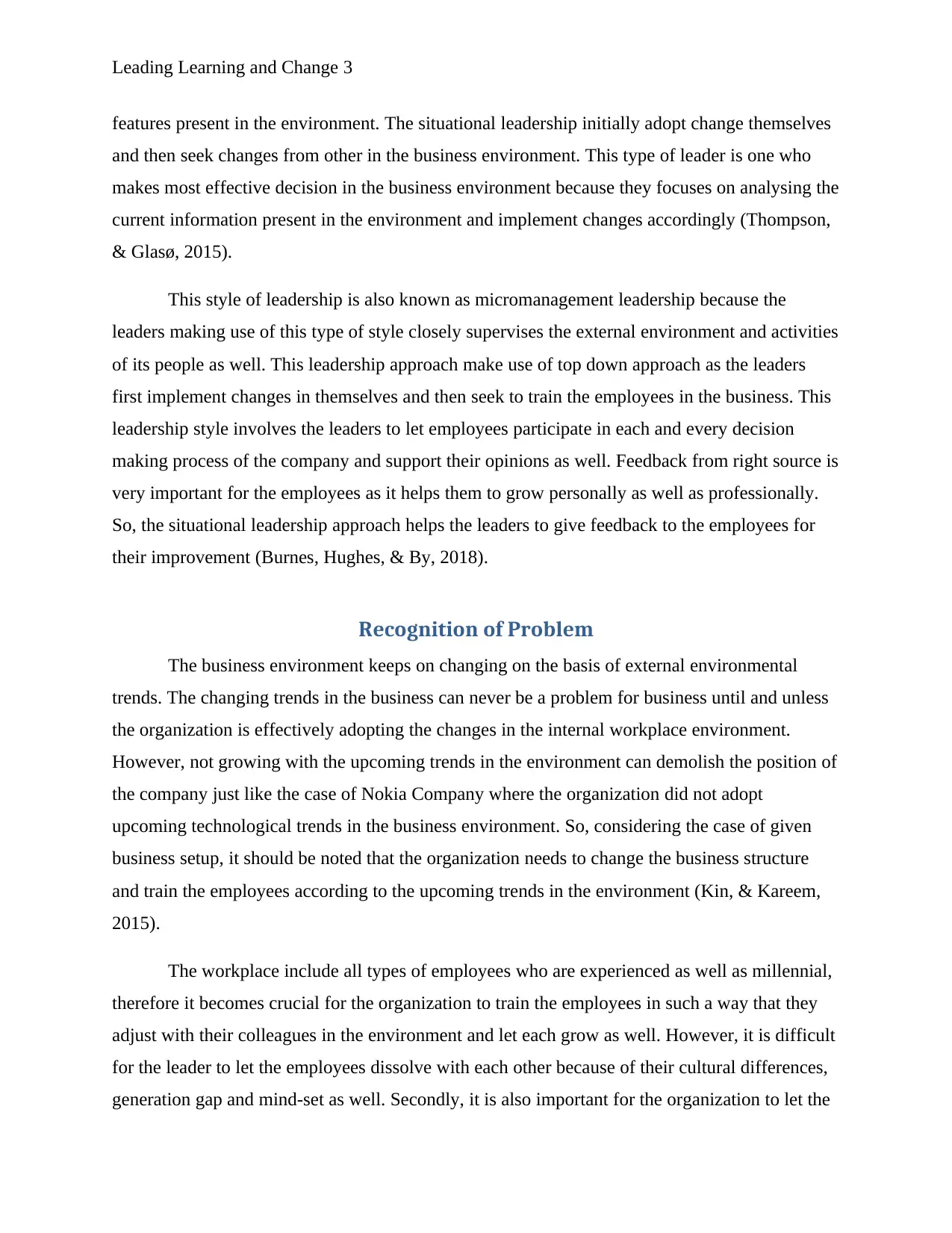
Leading Learning and Change 3
features present in the environment. The situational leadership initially adopt change themselves
and then seek changes from other in the business environment. This type of leader is one who
makes most effective decision in the business environment because they focuses on analysing the
current information present in the environment and implement changes accordingly (Thompson,
& Glasø, 2015).
This style of leadership is also known as micromanagement leadership because the
leaders making use of this type of style closely supervises the external environment and activities
of its people as well. This leadership approach make use of top down approach as the leaders
first implement changes in themselves and then seek to train the employees in the business. This
leadership style involves the leaders to let employees participate in each and every decision
making process of the company and support their opinions as well. Feedback from right source is
very important for the employees as it helps them to grow personally as well as professionally.
So, the situational leadership approach helps the leaders to give feedback to the employees for
their improvement (Burnes, Hughes, & By, 2018).
Recognition of Problem
The business environment keeps on changing on the basis of external environmental
trends. The changing trends in the business can never be a problem for business until and unless
the organization is effectively adopting the changes in the internal workplace environment.
However, not growing with the upcoming trends in the environment can demolish the position of
the company just like the case of Nokia Company where the organization did not adopt
upcoming technological trends in the business environment. So, considering the case of given
business setup, it should be noted that the organization needs to change the business structure
and train the employees according to the upcoming trends in the environment (Kin, & Kareem,
2015).
The workplace include all types of employees who are experienced as well as millennial,
therefore it becomes crucial for the organization to train the employees in such a way that they
adjust with their colleagues in the environment and let each grow as well. However, it is difficult
for the leader to let the employees dissolve with each other because of their cultural differences,
generation gap and mind-set as well. Secondly, it is also important for the organization to let the
features present in the environment. The situational leadership initially adopt change themselves
and then seek changes from other in the business environment. This type of leader is one who
makes most effective decision in the business environment because they focuses on analysing the
current information present in the environment and implement changes accordingly (Thompson,
& Glasø, 2015).
This style of leadership is also known as micromanagement leadership because the
leaders making use of this type of style closely supervises the external environment and activities
of its people as well. This leadership approach make use of top down approach as the leaders
first implement changes in themselves and then seek to train the employees in the business. This
leadership style involves the leaders to let employees participate in each and every decision
making process of the company and support their opinions as well. Feedback from right source is
very important for the employees as it helps them to grow personally as well as professionally.
So, the situational leadership approach helps the leaders to give feedback to the employees for
their improvement (Burnes, Hughes, & By, 2018).
Recognition of Problem
The business environment keeps on changing on the basis of external environmental
trends. The changing trends in the business can never be a problem for business until and unless
the organization is effectively adopting the changes in the internal workplace environment.
However, not growing with the upcoming trends in the environment can demolish the position of
the company just like the case of Nokia Company where the organization did not adopt
upcoming technological trends in the business environment. So, considering the case of given
business setup, it should be noted that the organization needs to change the business structure
and train the employees according to the upcoming trends in the environment (Kin, & Kareem,
2015).
The workplace include all types of employees who are experienced as well as millennial,
therefore it becomes crucial for the organization to train the employees in such a way that they
adjust with their colleagues in the environment and let each grow as well. However, it is difficult
for the leader to let the employees dissolve with each other because of their cultural differences,
generation gap and mind-set as well. Secondly, it is also important for the organization to let the
Paraphrase This Document
Need a fresh take? Get an instant paraphrase of this document with our AI Paraphraser
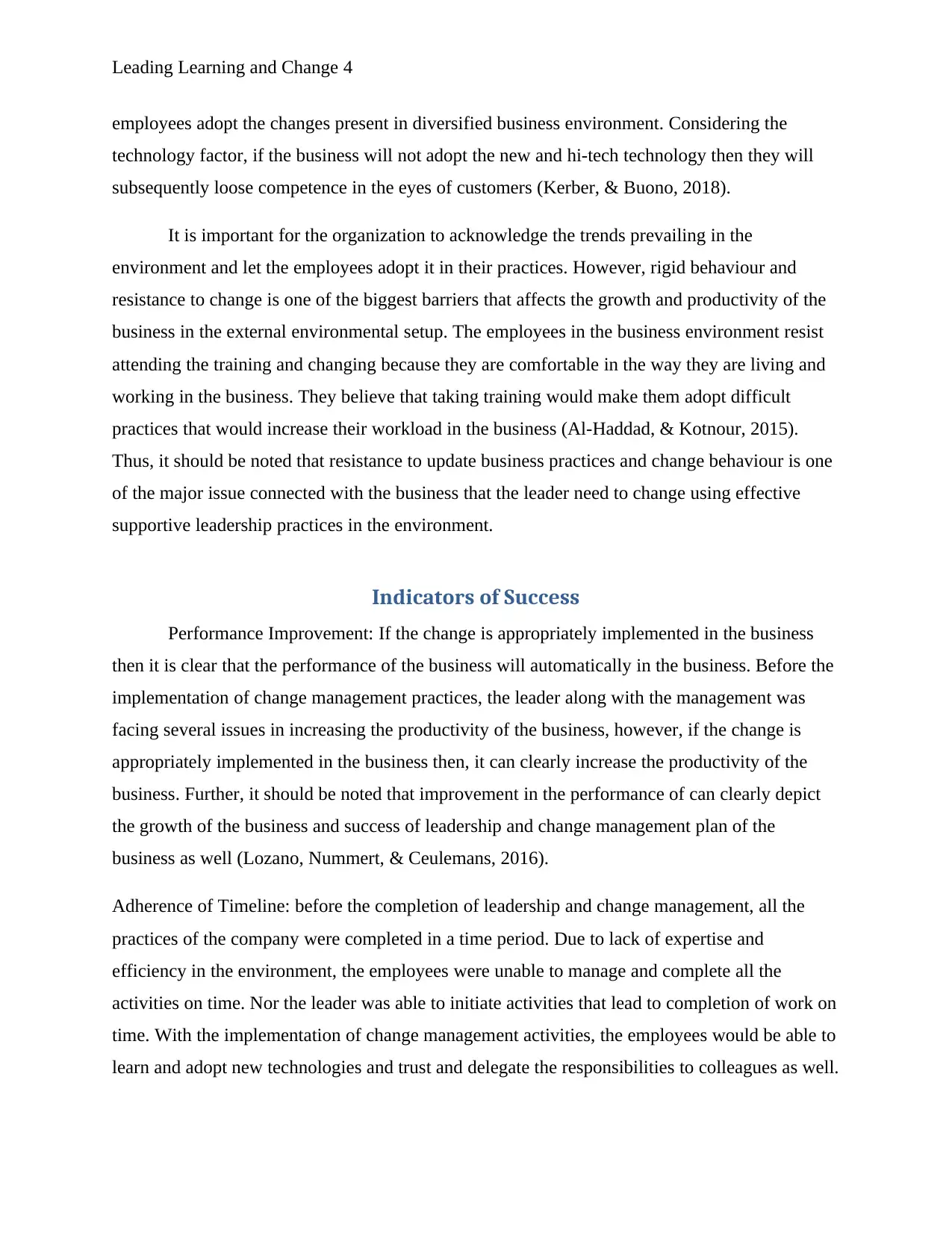
Leading Learning and Change 4
employees adopt the changes present in diversified business environment. Considering the
technology factor, if the business will not adopt the new and hi-tech technology then they will
subsequently loose competence in the eyes of customers (Kerber, & Buono, 2018).
It is important for the organization to acknowledge the trends prevailing in the
environment and let the employees adopt it in their practices. However, rigid behaviour and
resistance to change is one of the biggest barriers that affects the growth and productivity of the
business in the external environmental setup. The employees in the business environment resist
attending the training and changing because they are comfortable in the way they are living and
working in the business. They believe that taking training would make them adopt difficult
practices that would increase their workload in the business (Al-Haddad, & Kotnour, 2015).
Thus, it should be noted that resistance to update business practices and change behaviour is one
of the major issue connected with the business that the leader need to change using effective
supportive leadership practices in the environment.
Indicators of Success
Performance Improvement: If the change is appropriately implemented in the business
then it is clear that the performance of the business will automatically in the business. Before the
implementation of change management practices, the leader along with the management was
facing several issues in increasing the productivity of the business, however, if the change is
appropriately implemented in the business then, it can clearly increase the productivity of the
business. Further, it should be noted that improvement in the performance of can clearly depict
the growth of the business and success of leadership and change management plan of the
business as well (Lozano, Nummert, & Ceulemans, 2016).
Adherence of Timeline: before the completion of leadership and change management, all the
practices of the company were completed in a time period. Due to lack of expertise and
efficiency in the environment, the employees were unable to manage and complete all the
activities on time. Nor the leader was able to initiate activities that lead to completion of work on
time. With the implementation of change management activities, the employees would be able to
learn and adopt new technologies and trust and delegate the responsibilities to colleagues as well.
employees adopt the changes present in diversified business environment. Considering the
technology factor, if the business will not adopt the new and hi-tech technology then they will
subsequently loose competence in the eyes of customers (Kerber, & Buono, 2018).
It is important for the organization to acknowledge the trends prevailing in the
environment and let the employees adopt it in their practices. However, rigid behaviour and
resistance to change is one of the biggest barriers that affects the growth and productivity of the
business in the external environmental setup. The employees in the business environment resist
attending the training and changing because they are comfortable in the way they are living and
working in the business. They believe that taking training would make them adopt difficult
practices that would increase their workload in the business (Al-Haddad, & Kotnour, 2015).
Thus, it should be noted that resistance to update business practices and change behaviour is one
of the major issue connected with the business that the leader need to change using effective
supportive leadership practices in the environment.
Indicators of Success
Performance Improvement: If the change is appropriately implemented in the business
then it is clear that the performance of the business will automatically in the business. Before the
implementation of change management practices, the leader along with the management was
facing several issues in increasing the productivity of the business, however, if the change is
appropriately implemented in the business then, it can clearly increase the productivity of the
business. Further, it should be noted that improvement in the performance of can clearly depict
the growth of the business and success of leadership and change management plan of the
business as well (Lozano, Nummert, & Ceulemans, 2016).
Adherence of Timeline: before the completion of leadership and change management, all the
practices of the company were completed in a time period. Due to lack of expertise and
efficiency in the environment, the employees were unable to manage and complete all the
activities on time. Nor the leader was able to initiate activities that lead to completion of work on
time. With the implementation of change management activities, the employees would be able to
learn and adopt new technologies and trust and delegate the responsibilities to colleagues as well.
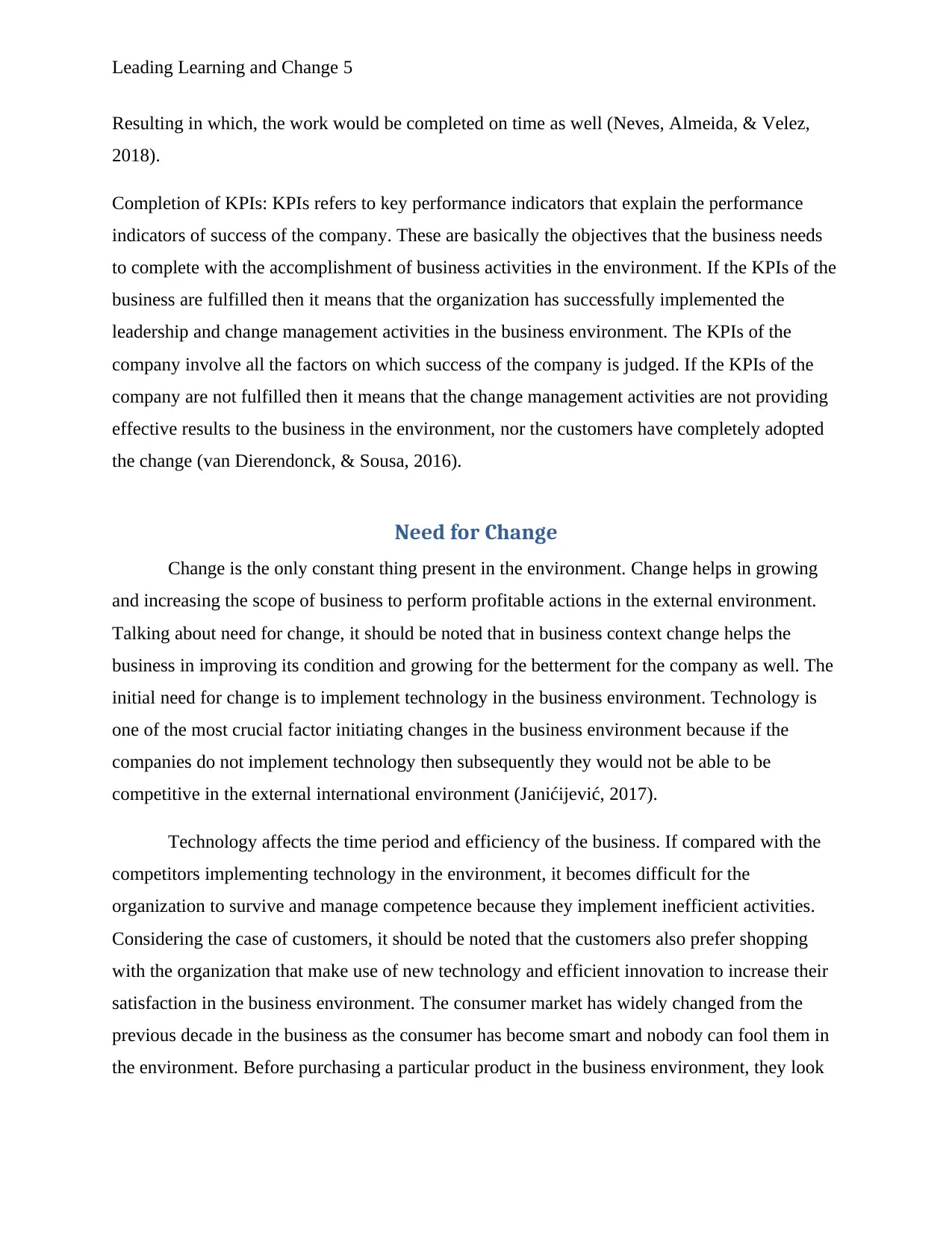
Leading Learning and Change 5
Resulting in which, the work would be completed on time as well (Neves, Almeida, & Velez,
2018).
Completion of KPIs: KPIs refers to key performance indicators that explain the performance
indicators of success of the company. These are basically the objectives that the business needs
to complete with the accomplishment of business activities in the environment. If the KPIs of the
business are fulfilled then it means that the organization has successfully implemented the
leadership and change management activities in the business environment. The KPIs of the
company involve all the factors on which success of the company is judged. If the KPIs of the
company are not fulfilled then it means that the change management activities are not providing
effective results to the business in the environment, nor the customers have completely adopted
the change (van Dierendonck, & Sousa, 2016).
Need for Change
Change is the only constant thing present in the environment. Change helps in growing
and increasing the scope of business to perform profitable actions in the external environment.
Talking about need for change, it should be noted that in business context change helps the
business in improving its condition and growing for the betterment for the company as well. The
initial need for change is to implement technology in the business environment. Technology is
one of the most crucial factor initiating changes in the business environment because if the
companies do not implement technology then subsequently they would not be able to be
competitive in the external international environment (Janićijević, 2017).
Technology affects the time period and efficiency of the business. If compared with the
competitors implementing technology in the environment, it becomes difficult for the
organization to survive and manage competence because they implement inefficient activities.
Considering the case of customers, it should be noted that the customers also prefer shopping
with the organization that make use of new technology and efficient innovation to increase their
satisfaction in the business environment. The consumer market has widely changed from the
previous decade in the business as the consumer has become smart and nobody can fool them in
the environment. Before purchasing a particular product in the business environment, they look
Resulting in which, the work would be completed on time as well (Neves, Almeida, & Velez,
2018).
Completion of KPIs: KPIs refers to key performance indicators that explain the performance
indicators of success of the company. These are basically the objectives that the business needs
to complete with the accomplishment of business activities in the environment. If the KPIs of the
business are fulfilled then it means that the organization has successfully implemented the
leadership and change management activities in the business environment. The KPIs of the
company involve all the factors on which success of the company is judged. If the KPIs of the
company are not fulfilled then it means that the change management activities are not providing
effective results to the business in the environment, nor the customers have completely adopted
the change (van Dierendonck, & Sousa, 2016).
Need for Change
Change is the only constant thing present in the environment. Change helps in growing
and increasing the scope of business to perform profitable actions in the external environment.
Talking about need for change, it should be noted that in business context change helps the
business in improving its condition and growing for the betterment for the company as well. The
initial need for change is to implement technology in the business environment. Technology is
one of the most crucial factor initiating changes in the business environment because if the
companies do not implement technology then subsequently they would not be able to be
competitive in the external international environment (Janićijević, 2017).
Technology affects the time period and efficiency of the business. If compared with the
competitors implementing technology in the environment, it becomes difficult for the
organization to survive and manage competence because they implement inefficient activities.
Considering the case of customers, it should be noted that the customers also prefer shopping
with the organization that make use of new technology and efficient innovation to increase their
satisfaction in the business environment. The consumer market has widely changed from the
previous decade in the business as the consumer has become smart and nobody can fool them in
the environment. Before purchasing a particular product in the business environment, they look
⊘ This is a preview!⊘
Do you want full access?
Subscribe today to unlock all pages.

Trusted by 1+ million students worldwide
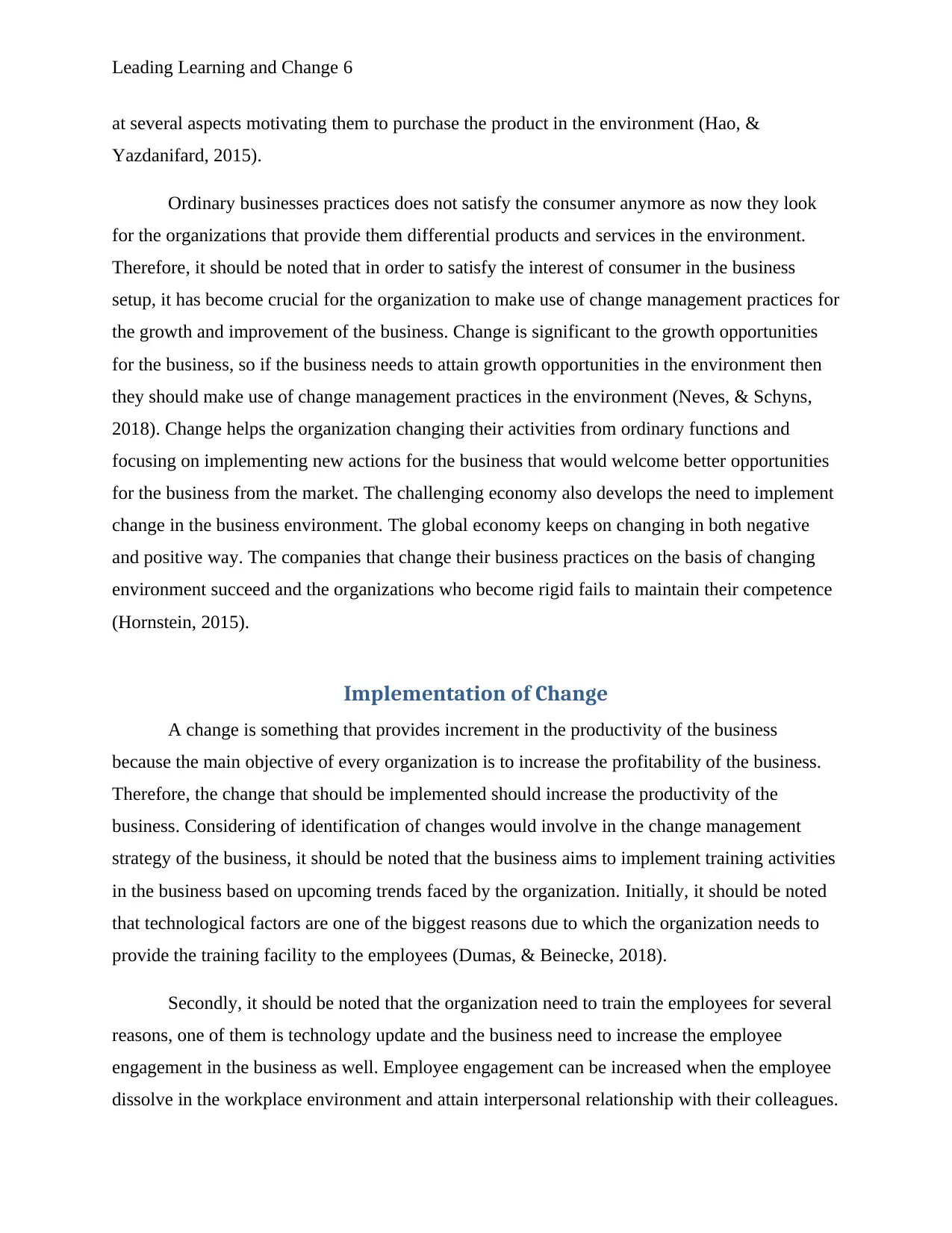
Leading Learning and Change 6
at several aspects motivating them to purchase the product in the environment (Hao, &
Yazdanifard, 2015).
Ordinary businesses practices does not satisfy the consumer anymore as now they look
for the organizations that provide them differential products and services in the environment.
Therefore, it should be noted that in order to satisfy the interest of consumer in the business
setup, it has become crucial for the organization to make use of change management practices for
the growth and improvement of the business. Change is significant to the growth opportunities
for the business, so if the business needs to attain growth opportunities in the environment then
they should make use of change management practices in the environment (Neves, & Schyns,
2018). Change helps the organization changing their activities from ordinary functions and
focusing on implementing new actions for the business that would welcome better opportunities
for the business from the market. The challenging economy also develops the need to implement
change in the business environment. The global economy keeps on changing in both negative
and positive way. The companies that change their business practices on the basis of changing
environment succeed and the organizations who become rigid fails to maintain their competence
(Hornstein, 2015).
Implementation of Change
A change is something that provides increment in the productivity of the business
because the main objective of every organization is to increase the profitability of the business.
Therefore, the change that should be implemented should increase the productivity of the
business. Considering of identification of changes would involve in the change management
strategy of the business, it should be noted that the business aims to implement training activities
in the business based on upcoming trends faced by the organization. Initially, it should be noted
that technological factors are one of the biggest reasons due to which the organization needs to
provide the training facility to the employees (Dumas, & Beinecke, 2018).
Secondly, it should be noted that the organization need to train the employees for several
reasons, one of them is technology update and the business need to increase the employee
engagement in the business as well. Employee engagement can be increased when the employee
dissolve in the workplace environment and attain interpersonal relationship with their colleagues.
at several aspects motivating them to purchase the product in the environment (Hao, &
Yazdanifard, 2015).
Ordinary businesses practices does not satisfy the consumer anymore as now they look
for the organizations that provide them differential products and services in the environment.
Therefore, it should be noted that in order to satisfy the interest of consumer in the business
setup, it has become crucial for the organization to make use of change management practices for
the growth and improvement of the business. Change is significant to the growth opportunities
for the business, so if the business needs to attain growth opportunities in the environment then
they should make use of change management practices in the environment (Neves, & Schyns,
2018). Change helps the organization changing their activities from ordinary functions and
focusing on implementing new actions for the business that would welcome better opportunities
for the business from the market. The challenging economy also develops the need to implement
change in the business environment. The global economy keeps on changing in both negative
and positive way. The companies that change their business practices on the basis of changing
environment succeed and the organizations who become rigid fails to maintain their competence
(Hornstein, 2015).
Implementation of Change
A change is something that provides increment in the productivity of the business
because the main objective of every organization is to increase the profitability of the business.
Therefore, the change that should be implemented should increase the productivity of the
business. Considering of identification of changes would involve in the change management
strategy of the business, it should be noted that the business aims to implement training activities
in the business based on upcoming trends faced by the organization. Initially, it should be noted
that technological factors are one of the biggest reasons due to which the organization needs to
provide the training facility to the employees (Dumas, & Beinecke, 2018).
Secondly, it should be noted that the organization need to train the employees for several
reasons, one of them is technology update and the business need to increase the employee
engagement in the business as well. Employee engagement can be increased when the employee
dissolve in the workplace environment and attain interpersonal relationship with their colleagues.
Paraphrase This Document
Need a fresh take? Get an instant paraphrase of this document with our AI Paraphraser
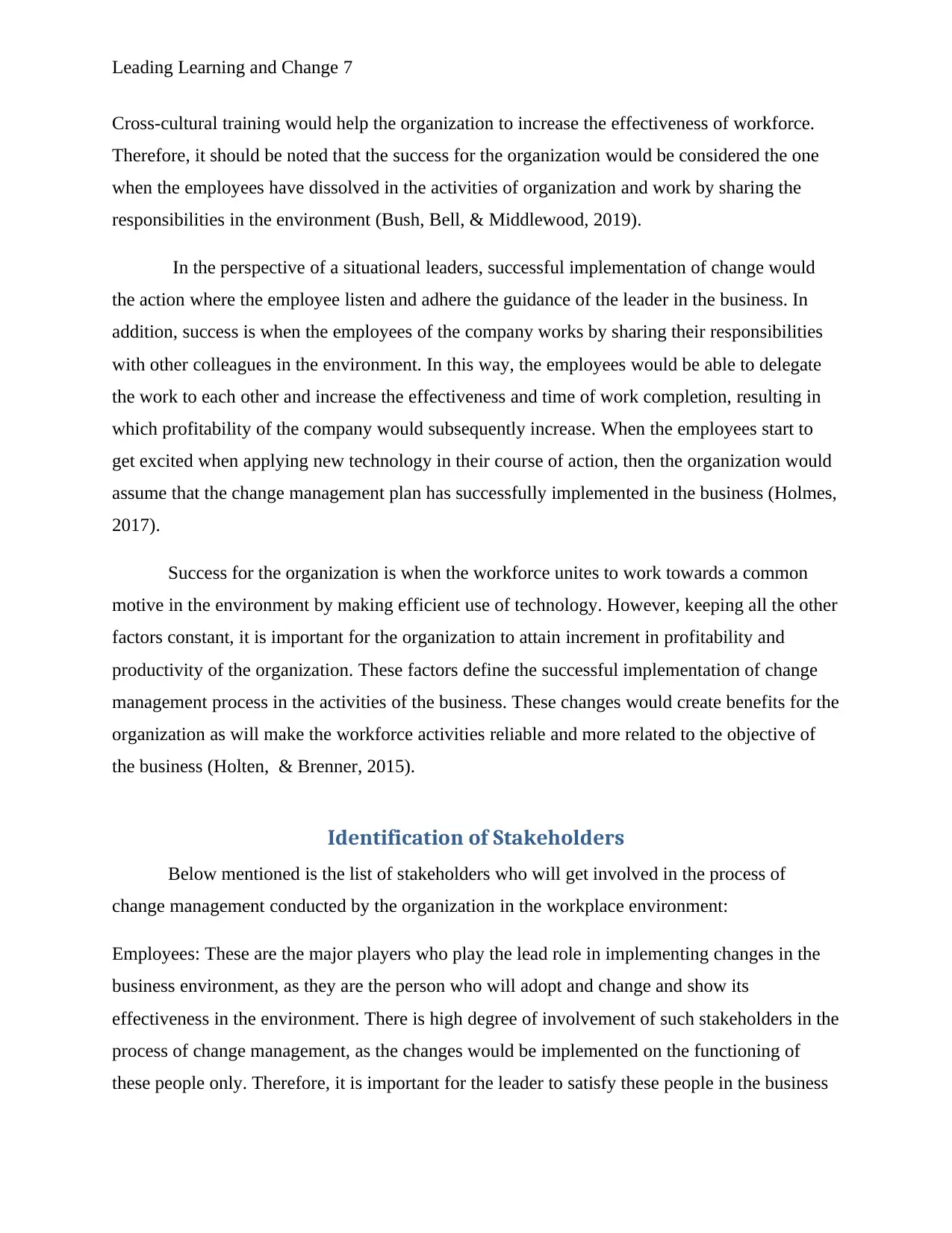
Leading Learning and Change 7
Cross-cultural training would help the organization to increase the effectiveness of workforce.
Therefore, it should be noted that the success for the organization would be considered the one
when the employees have dissolved in the activities of organization and work by sharing the
responsibilities in the environment (Bush, Bell, & Middlewood, 2019).
In the perspective of a situational leaders, successful implementation of change would
the action where the employee listen and adhere the guidance of the leader in the business. In
addition, success is when the employees of the company works by sharing their responsibilities
with other colleagues in the environment. In this way, the employees would be able to delegate
the work to each other and increase the effectiveness and time of work completion, resulting in
which profitability of the company would subsequently increase. When the employees start to
get excited when applying new technology in their course of action, then the organization would
assume that the change management plan has successfully implemented in the business (Holmes,
2017).
Success for the organization is when the workforce unites to work towards a common
motive in the environment by making efficient use of technology. However, keeping all the other
factors constant, it is important for the organization to attain increment in profitability and
productivity of the organization. These factors define the successful implementation of change
management process in the activities of the business. These changes would create benefits for the
organization as will make the workforce activities reliable and more related to the objective of
the business (Holten, & Brenner, 2015).
Identification of Stakeholders
Below mentioned is the list of stakeholders who will get involved in the process of
change management conducted by the organization in the workplace environment:
Employees: These are the major players who play the lead role in implementing changes in the
business environment, as they are the person who will adopt and change and show its
effectiveness in the environment. There is high degree of involvement of such stakeholders in the
process of change management, as the changes would be implemented on the functioning of
these people only. Therefore, it is important for the leader to satisfy these people in the business
Cross-cultural training would help the organization to increase the effectiveness of workforce.
Therefore, it should be noted that the success for the organization would be considered the one
when the employees have dissolved in the activities of organization and work by sharing the
responsibilities in the environment (Bush, Bell, & Middlewood, 2019).
In the perspective of a situational leaders, successful implementation of change would
the action where the employee listen and adhere the guidance of the leader in the business. In
addition, success is when the employees of the company works by sharing their responsibilities
with other colleagues in the environment. In this way, the employees would be able to delegate
the work to each other and increase the effectiveness and time of work completion, resulting in
which profitability of the company would subsequently increase. When the employees start to
get excited when applying new technology in their course of action, then the organization would
assume that the change management plan has successfully implemented in the business (Holmes,
2017).
Success for the organization is when the workforce unites to work towards a common
motive in the environment by making efficient use of technology. However, keeping all the other
factors constant, it is important for the organization to attain increment in profitability and
productivity of the organization. These factors define the successful implementation of change
management process in the activities of the business. These changes would create benefits for the
organization as will make the workforce activities reliable and more related to the objective of
the business (Holten, & Brenner, 2015).
Identification of Stakeholders
Below mentioned is the list of stakeholders who will get involved in the process of
change management conducted by the organization in the workplace environment:
Employees: These are the major players who play the lead role in implementing changes in the
business environment, as they are the person who will adopt and change and show its
effectiveness in the environment. There is high degree of involvement of such stakeholders in the
process of change management, as the changes would be implemented on the functioning of
these people only. Therefore, it is important for the leader to satisfy these people in the business
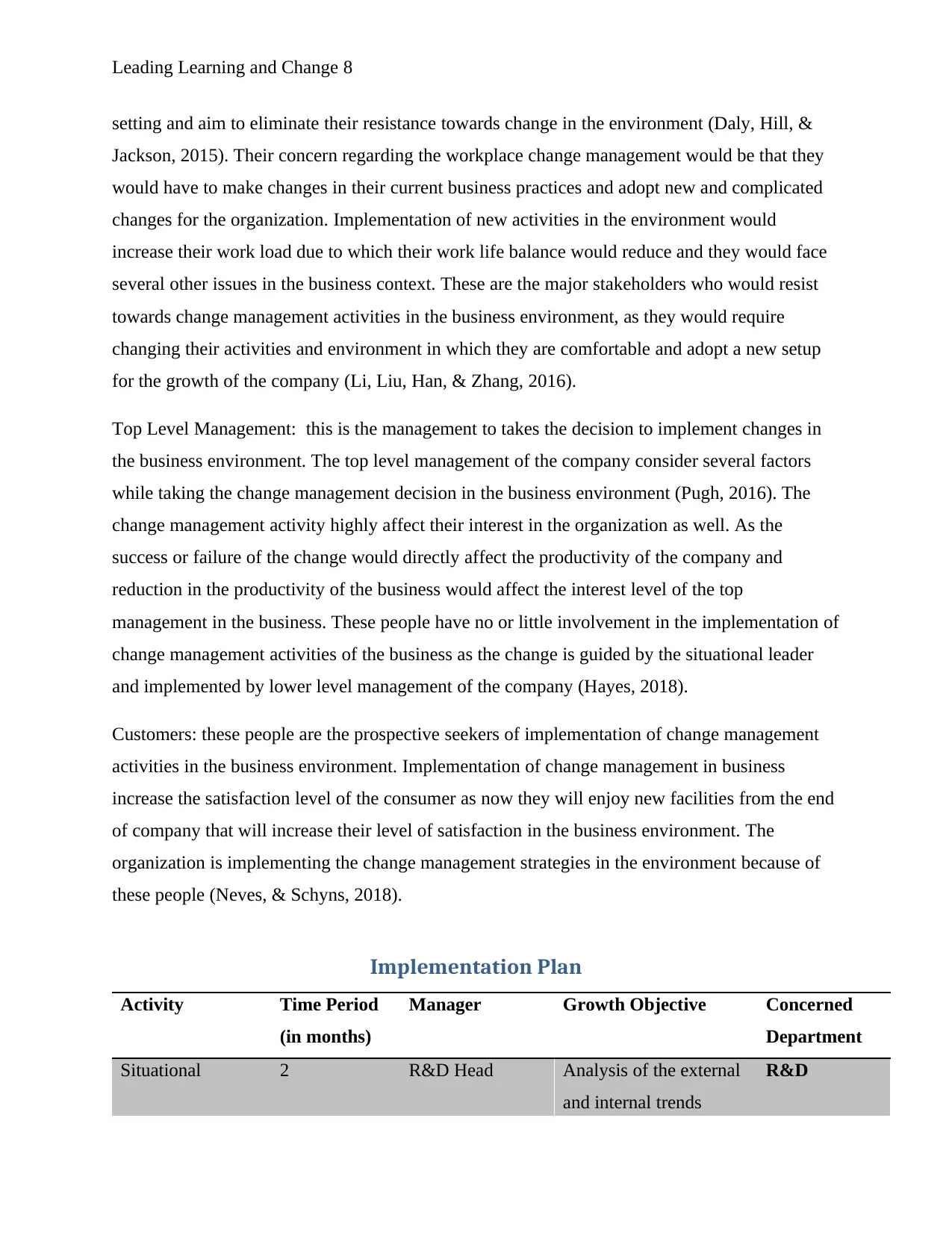
Leading Learning and Change 8
setting and aim to eliminate their resistance towards change in the environment (Daly, Hill, &
Jackson, 2015). Their concern regarding the workplace change management would be that they
would have to make changes in their current business practices and adopt new and complicated
changes for the organization. Implementation of new activities in the environment would
increase their work load due to which their work life balance would reduce and they would face
several other issues in the business context. These are the major stakeholders who would resist
towards change management activities in the business environment, as they would require
changing their activities and environment in which they are comfortable and adopt a new setup
for the growth of the company (Li, Liu, Han, & Zhang, 2016).
Top Level Management: this is the management to takes the decision to implement changes in
the business environment. The top level management of the company consider several factors
while taking the change management decision in the business environment (Pugh, 2016). The
change management activity highly affect their interest in the organization as well. As the
success or failure of the change would directly affect the productivity of the company and
reduction in the productivity of the business would affect the interest level of the top
management in the business. These people have no or little involvement in the implementation of
change management activities of the business as the change is guided by the situational leader
and implemented by lower level management of the company (Hayes, 2018).
Customers: these people are the prospective seekers of implementation of change management
activities in the business environment. Implementation of change management in business
increase the satisfaction level of the consumer as now they will enjoy new facilities from the end
of company that will increase their level of satisfaction in the business environment. The
organization is implementing the change management strategies in the environment because of
these people (Neves, & Schyns, 2018).
Implementation Plan
Activity Time Period
(in months)
Manager Growth Objective Concerned
Department
Situational 2 R&D Head Analysis of the external
and internal trends
R&D
setting and aim to eliminate their resistance towards change in the environment (Daly, Hill, &
Jackson, 2015). Their concern regarding the workplace change management would be that they
would have to make changes in their current business practices and adopt new and complicated
changes for the organization. Implementation of new activities in the environment would
increase their work load due to which their work life balance would reduce and they would face
several other issues in the business context. These are the major stakeholders who would resist
towards change management activities in the business environment, as they would require
changing their activities and environment in which they are comfortable and adopt a new setup
for the growth of the company (Li, Liu, Han, & Zhang, 2016).
Top Level Management: this is the management to takes the decision to implement changes in
the business environment. The top level management of the company consider several factors
while taking the change management decision in the business environment (Pugh, 2016). The
change management activity highly affect their interest in the organization as well. As the
success or failure of the change would directly affect the productivity of the company and
reduction in the productivity of the business would affect the interest level of the top
management in the business. These people have no or little involvement in the implementation of
change management activities of the business as the change is guided by the situational leader
and implemented by lower level management of the company (Hayes, 2018).
Customers: these people are the prospective seekers of implementation of change management
activities in the business environment. Implementation of change management in business
increase the satisfaction level of the consumer as now they will enjoy new facilities from the end
of company that will increase their level of satisfaction in the business environment. The
organization is implementing the change management strategies in the environment because of
these people (Neves, & Schyns, 2018).
Implementation Plan
Activity Time Period
(in months)
Manager Growth Objective Concerned
Department
Situational 2 R&D Head Analysis of the external
and internal trends
R&D
⊘ This is a preview!⊘
Do you want full access?
Subscribe today to unlock all pages.

Trusted by 1+ million students worldwide
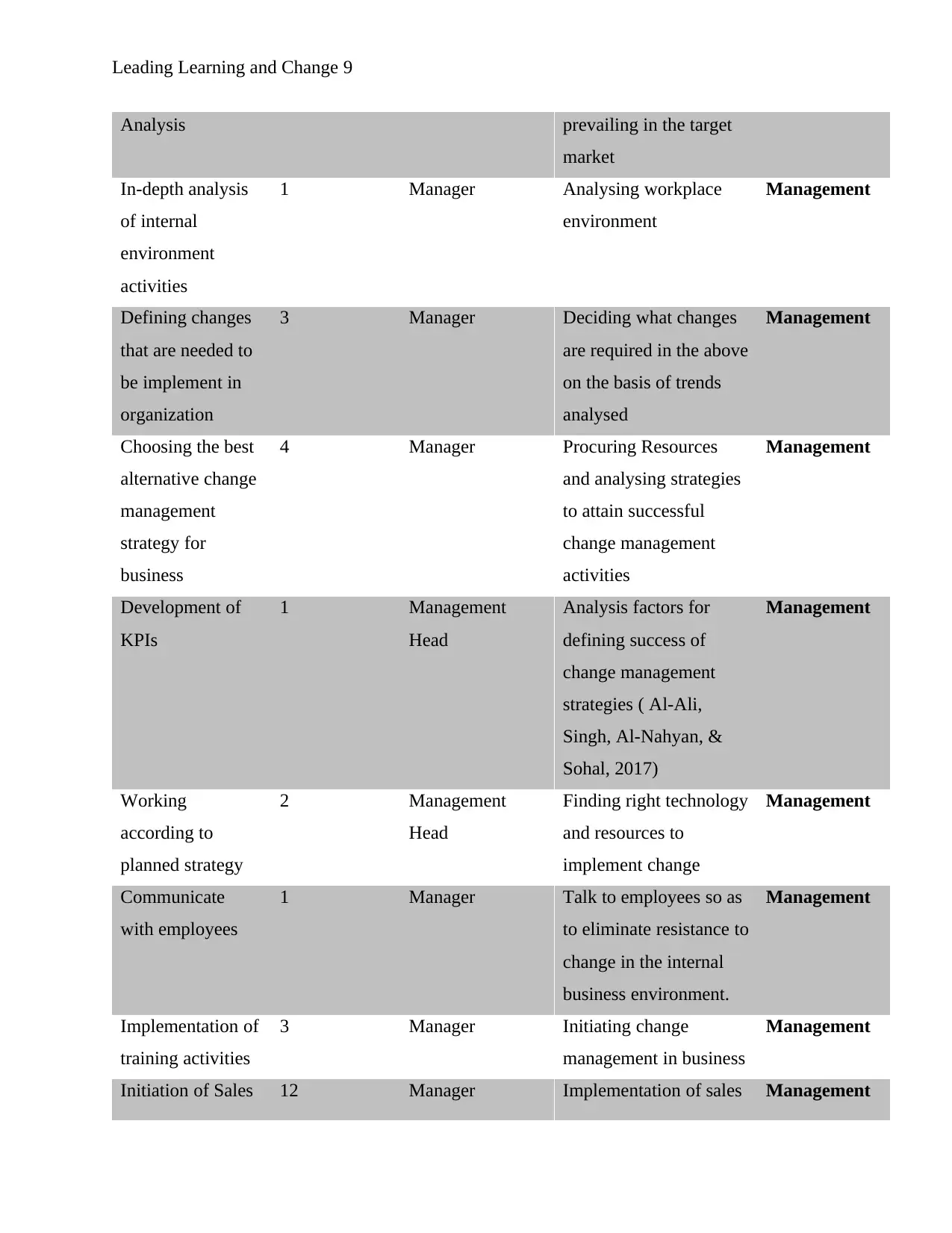
Leading Learning and Change 9
Analysis prevailing in the target
market
In-depth analysis
of internal
environment
activities
1 Manager Analysing workplace
environment
Management
Defining changes
that are needed to
be implement in
organization
3 Manager Deciding what changes
are required in the above
on the basis of trends
analysed
Management
Choosing the best
alternative change
management
strategy for
business
4 Manager Procuring Resources
and analysing strategies
to attain successful
change management
activities
Management
Development of
KPIs
1 Management
Head
Analysis factors for
defining success of
change management
strategies ( Al-Ali,
Singh, Al-Nahyan, &
Sohal, 2017)
Management
Working
according to
planned strategy
2 Management
Head
Finding right technology
and resources to
implement change
Management
Communicate
with employees
1 Manager Talk to employees so as
to eliminate resistance to
change in the internal
business environment.
Management
Implementation of
training activities
3 Manager Initiating change
management in business
Management
Initiation of Sales 12 Manager Implementation of sales Management
Analysis prevailing in the target
market
In-depth analysis
of internal
environment
activities
1 Manager Analysing workplace
environment
Management
Defining changes
that are needed to
be implement in
organization
3 Manager Deciding what changes
are required in the above
on the basis of trends
analysed
Management
Choosing the best
alternative change
management
strategy for
business
4 Manager Procuring Resources
and analysing strategies
to attain successful
change management
activities
Management
Development of
KPIs
1 Management
Head
Analysis factors for
defining success of
change management
strategies ( Al-Ali,
Singh, Al-Nahyan, &
Sohal, 2017)
Management
Working
according to
planned strategy
2 Management
Head
Finding right technology
and resources to
implement change
Management
Communicate
with employees
1 Manager Talk to employees so as
to eliminate resistance to
change in the internal
business environment.
Management
Implementation of
training activities
3 Manager Initiating change
management in business
Management
Initiation of Sales 12 Manager Implementation of sales Management
Paraphrase This Document
Need a fresh take? Get an instant paraphrase of this document with our AI Paraphraser
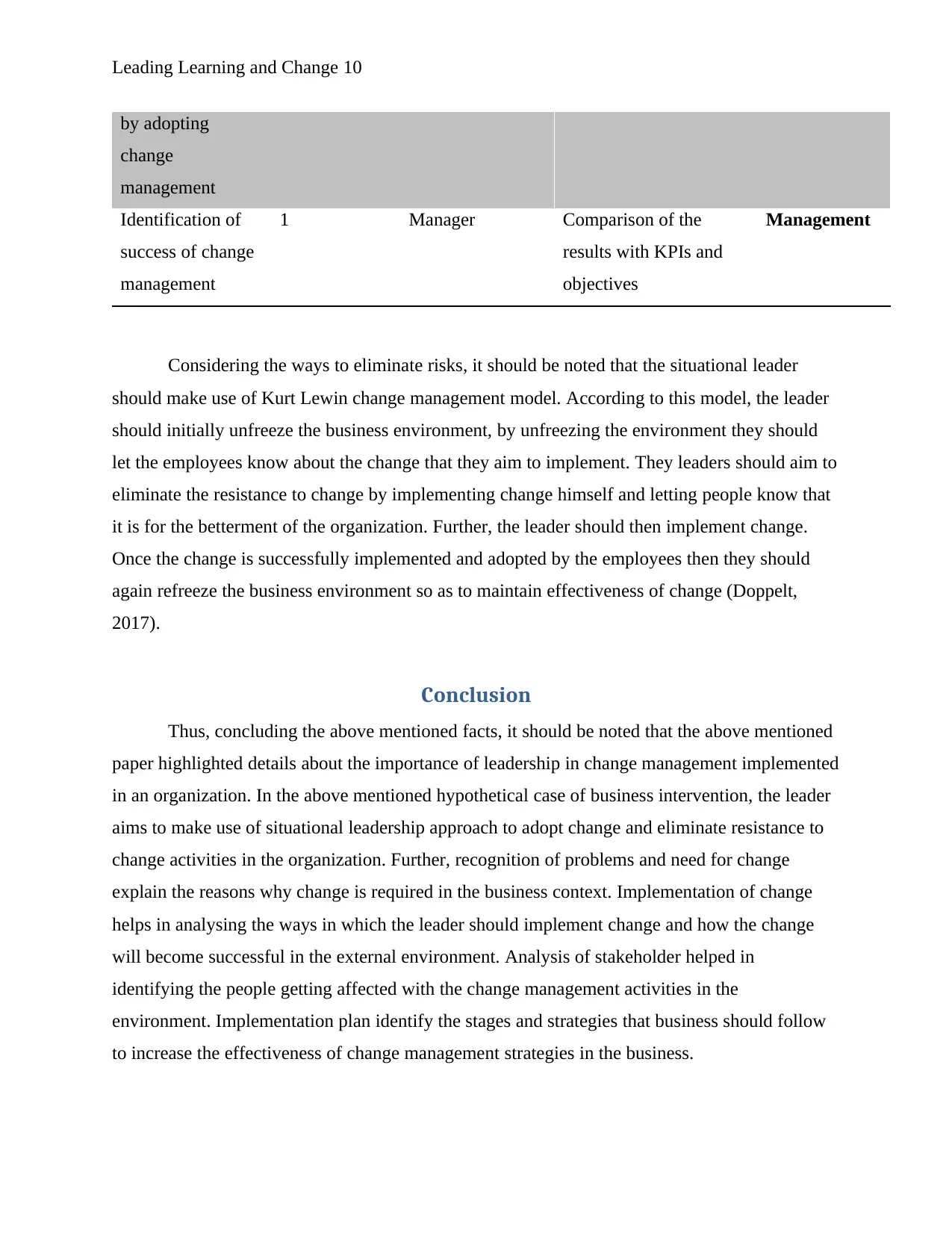
Leading Learning and Change 10
by adopting
change
management
Identification of
success of change
management
1 Manager Comparison of the
results with KPIs and
objectives
Management
Considering the ways to eliminate risks, it should be noted that the situational leader
should make use of Kurt Lewin change management model. According to this model, the leader
should initially unfreeze the business environment, by unfreezing the environment they should
let the employees know about the change that they aim to implement. They leaders should aim to
eliminate the resistance to change by implementing change himself and letting people know that
it is for the betterment of the organization. Further, the leader should then implement change.
Once the change is successfully implemented and adopted by the employees then they should
again refreeze the business environment so as to maintain effectiveness of change (Doppelt,
2017).
Conclusion
Thus, concluding the above mentioned facts, it should be noted that the above mentioned
paper highlighted details about the importance of leadership in change management implemented
in an organization. In the above mentioned hypothetical case of business intervention, the leader
aims to make use of situational leadership approach to adopt change and eliminate resistance to
change activities in the organization. Further, recognition of problems and need for change
explain the reasons why change is required in the business context. Implementation of change
helps in analysing the ways in which the leader should implement change and how the change
will become successful in the external environment. Analysis of stakeholder helped in
identifying the people getting affected with the change management activities in the
environment. Implementation plan identify the stages and strategies that business should follow
to increase the effectiveness of change management strategies in the business.
by adopting
change
management
Identification of
success of change
management
1 Manager Comparison of the
results with KPIs and
objectives
Management
Considering the ways to eliminate risks, it should be noted that the situational leader
should make use of Kurt Lewin change management model. According to this model, the leader
should initially unfreeze the business environment, by unfreezing the environment they should
let the employees know about the change that they aim to implement. They leaders should aim to
eliminate the resistance to change by implementing change himself and letting people know that
it is for the betterment of the organization. Further, the leader should then implement change.
Once the change is successfully implemented and adopted by the employees then they should
again refreeze the business environment so as to maintain effectiveness of change (Doppelt,
2017).
Conclusion
Thus, concluding the above mentioned facts, it should be noted that the above mentioned
paper highlighted details about the importance of leadership in change management implemented
in an organization. In the above mentioned hypothetical case of business intervention, the leader
aims to make use of situational leadership approach to adopt change and eliminate resistance to
change activities in the organization. Further, recognition of problems and need for change
explain the reasons why change is required in the business context. Implementation of change
helps in analysing the ways in which the leader should implement change and how the change
will become successful in the external environment. Analysis of stakeholder helped in
identifying the people getting affected with the change management activities in the
environment. Implementation plan identify the stages and strategies that business should follow
to increase the effectiveness of change management strategies in the business.
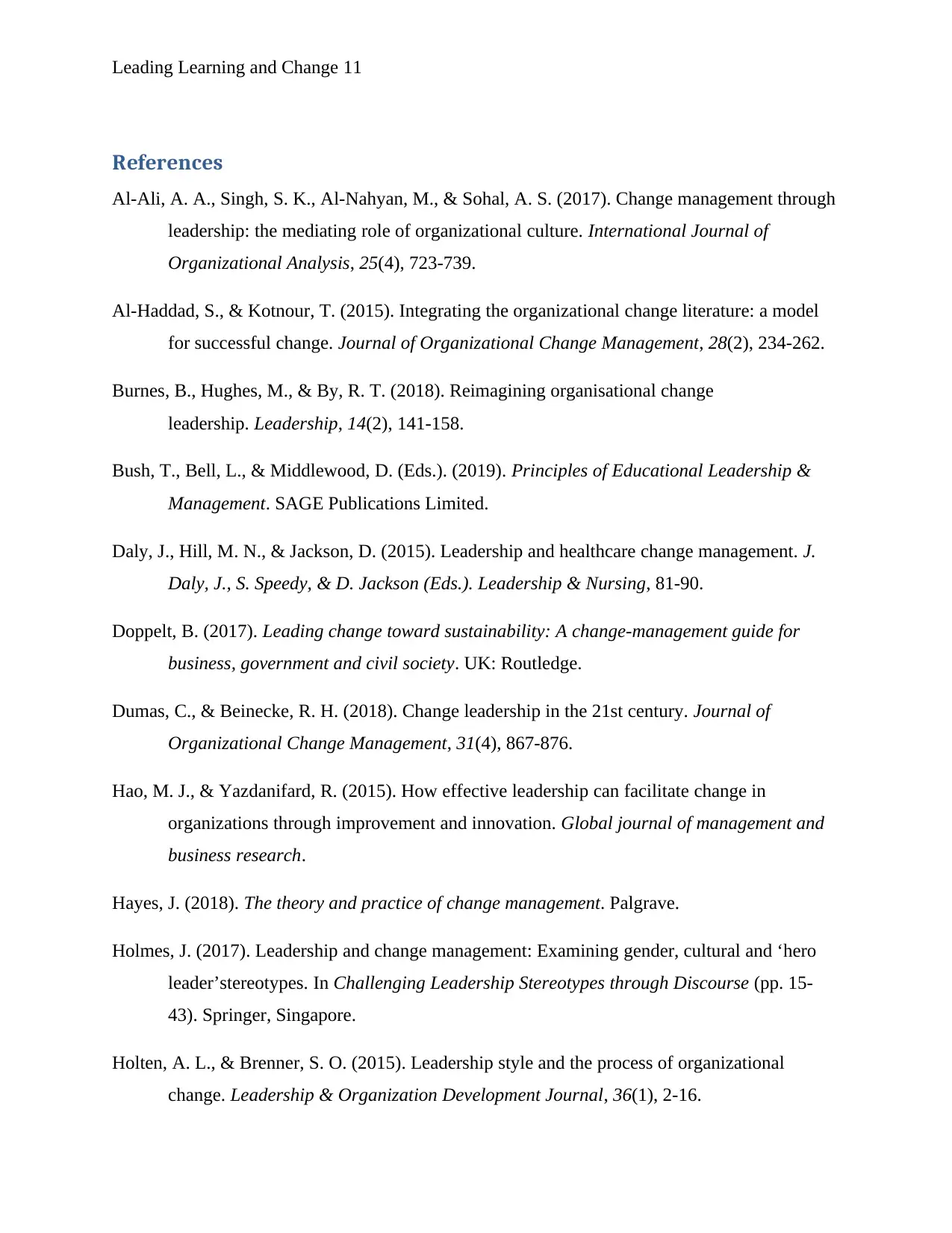
Leading Learning and Change 11
References
Al-Ali, A. A., Singh, S. K., Al-Nahyan, M., & Sohal, A. S. (2017). Change management through
leadership: the mediating role of organizational culture. International Journal of
Organizational Analysis, 25(4), 723-739.
Al-Haddad, S., & Kotnour, T. (2015). Integrating the organizational change literature: a model
for successful change. Journal of Organizational Change Management, 28(2), 234-262.
Burnes, B., Hughes, M., & By, R. T. (2018). Reimagining organisational change
leadership. Leadership, 14(2), 141-158.
Bush, T., Bell, L., & Middlewood, D. (Eds.). (2019). Principles of Educational Leadership &
Management. SAGE Publications Limited.
Daly, J., Hill, M. N., & Jackson, D. (2015). Leadership and healthcare change management. J.
Daly, J., S. Speedy, & D. Jackson (Eds.). Leadership & Nursing, 81-90.
Doppelt, B. (2017). Leading change toward sustainability: A change-management guide for
business, government and civil society. UK: Routledge.
Dumas, C., & Beinecke, R. H. (2018). Change leadership in the 21st century. Journal of
Organizational Change Management, 31(4), 867-876.
Hao, M. J., & Yazdanifard, R. (2015). How effective leadership can facilitate change in
organizations through improvement and innovation. Global journal of management and
business research.
Hayes, J. (2018). The theory and practice of change management. Palgrave.
Holmes, J. (2017). Leadership and change management: Examining gender, cultural and ‘hero
leader’stereotypes. In Challenging Leadership Stereotypes through Discourse (pp. 15-
43). Springer, Singapore.
Holten, A. L., & Brenner, S. O. (2015). Leadership style and the process of organizational
change. Leadership & Organization Development Journal, 36(1), 2-16.
References
Al-Ali, A. A., Singh, S. K., Al-Nahyan, M., & Sohal, A. S. (2017). Change management through
leadership: the mediating role of organizational culture. International Journal of
Organizational Analysis, 25(4), 723-739.
Al-Haddad, S., & Kotnour, T. (2015). Integrating the organizational change literature: a model
for successful change. Journal of Organizational Change Management, 28(2), 234-262.
Burnes, B., Hughes, M., & By, R. T. (2018). Reimagining organisational change
leadership. Leadership, 14(2), 141-158.
Bush, T., Bell, L., & Middlewood, D. (Eds.). (2019). Principles of Educational Leadership &
Management. SAGE Publications Limited.
Daly, J., Hill, M. N., & Jackson, D. (2015). Leadership and healthcare change management. J.
Daly, J., S. Speedy, & D. Jackson (Eds.). Leadership & Nursing, 81-90.
Doppelt, B. (2017). Leading change toward sustainability: A change-management guide for
business, government and civil society. UK: Routledge.
Dumas, C., & Beinecke, R. H. (2018). Change leadership in the 21st century. Journal of
Organizational Change Management, 31(4), 867-876.
Hao, M. J., & Yazdanifard, R. (2015). How effective leadership can facilitate change in
organizations through improvement and innovation. Global journal of management and
business research.
Hayes, J. (2018). The theory and practice of change management. Palgrave.
Holmes, J. (2017). Leadership and change management: Examining gender, cultural and ‘hero
leader’stereotypes. In Challenging Leadership Stereotypes through Discourse (pp. 15-
43). Springer, Singapore.
Holten, A. L., & Brenner, S. O. (2015). Leadership style and the process of organizational
change. Leadership & Organization Development Journal, 36(1), 2-16.
⊘ This is a preview!⊘
Do you want full access?
Subscribe today to unlock all pages.

Trusted by 1+ million students worldwide
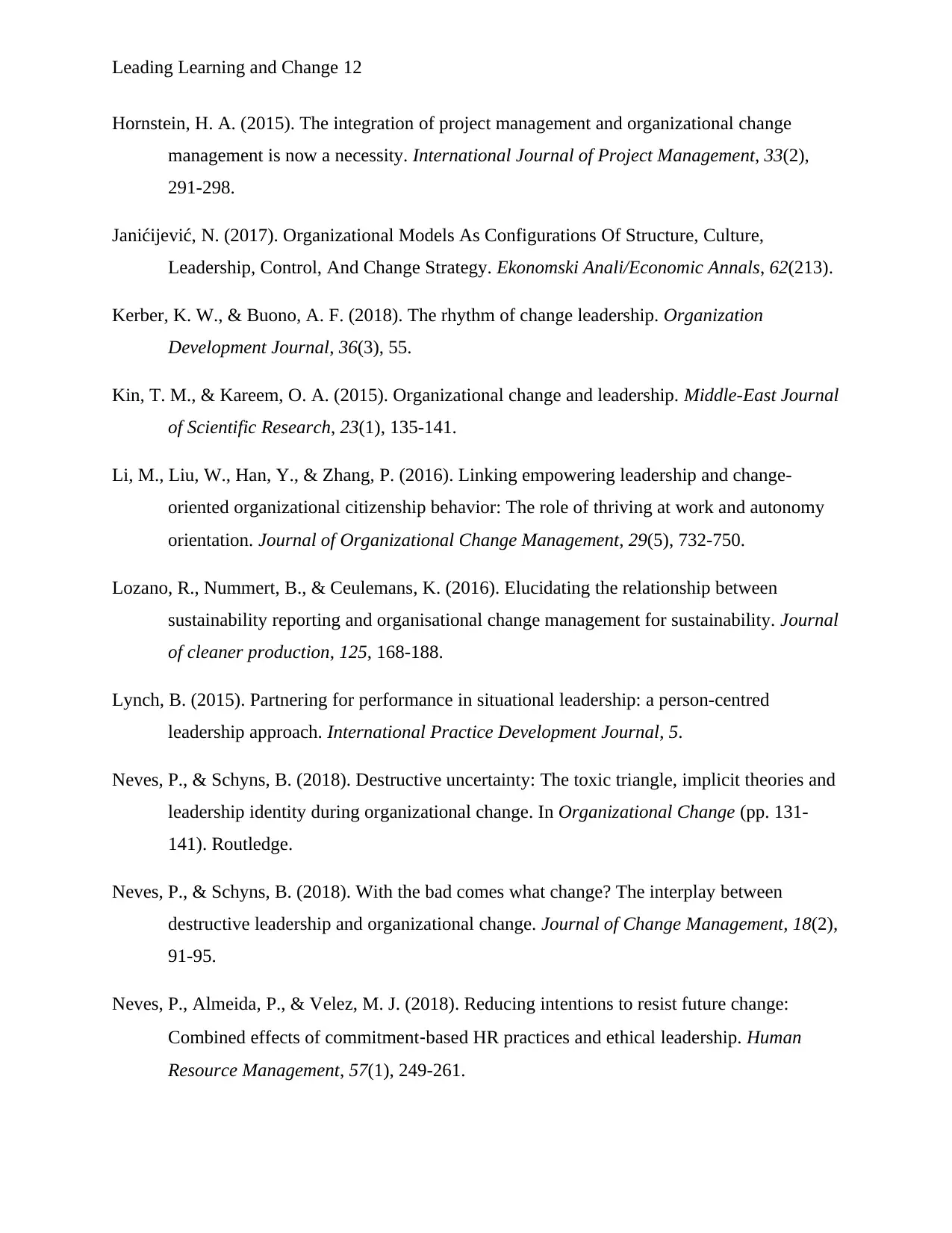
Leading Learning and Change 12
Hornstein, H. A. (2015). The integration of project management and organizational change
management is now a necessity. International Journal of Project Management, 33(2),
291-298.
Janićijević, N. (2017). Organizational Models As Configurations Of Structure, Culture,
Leadership, Control, And Change Strategy. Ekonomski Anali/Economic Annals, 62(213).
Kerber, K. W., & Buono, A. F. (2018). The rhythm of change leadership. Organization
Development Journal, 36(3), 55.
Kin, T. M., & Kareem, O. A. (2015). Organizational change and leadership. Middle-East Journal
of Scientific Research, 23(1), 135-141.
Li, M., Liu, W., Han, Y., & Zhang, P. (2016). Linking empowering leadership and change-
oriented organizational citizenship behavior: The role of thriving at work and autonomy
orientation. Journal of Organizational Change Management, 29(5), 732-750.
Lozano, R., Nummert, B., & Ceulemans, K. (2016). Elucidating the relationship between
sustainability reporting and organisational change management for sustainability. Journal
of cleaner production, 125, 168-188.
Lynch, B. (2015). Partnering for performance in situational leadership: a person-centred
leadership approach. International Practice Development Journal, 5.
Neves, P., & Schyns, B. (2018). Destructive uncertainty: The toxic triangle, implicit theories and
leadership identity during organizational change. In Organizational Change (pp. 131-
141). Routledge.
Neves, P., & Schyns, B. (2018). With the bad comes what change? The interplay between
destructive leadership and organizational change. Journal of Change Management, 18(2),
91-95.
Neves, P., Almeida, P., & Velez, M. J. (2018). Reducing intentions to resist future change:
Combined effects of commitment‐based HR practices and ethical leadership. Human
Resource Management, 57(1), 249-261.
Hornstein, H. A. (2015). The integration of project management and organizational change
management is now a necessity. International Journal of Project Management, 33(2),
291-298.
Janićijević, N. (2017). Organizational Models As Configurations Of Structure, Culture,
Leadership, Control, And Change Strategy. Ekonomski Anali/Economic Annals, 62(213).
Kerber, K. W., & Buono, A. F. (2018). The rhythm of change leadership. Organization
Development Journal, 36(3), 55.
Kin, T. M., & Kareem, O. A. (2015). Organizational change and leadership. Middle-East Journal
of Scientific Research, 23(1), 135-141.
Li, M., Liu, W., Han, Y., & Zhang, P. (2016). Linking empowering leadership and change-
oriented organizational citizenship behavior: The role of thriving at work and autonomy
orientation. Journal of Organizational Change Management, 29(5), 732-750.
Lozano, R., Nummert, B., & Ceulemans, K. (2016). Elucidating the relationship between
sustainability reporting and organisational change management for sustainability. Journal
of cleaner production, 125, 168-188.
Lynch, B. (2015). Partnering for performance in situational leadership: a person-centred
leadership approach. International Practice Development Journal, 5.
Neves, P., & Schyns, B. (2018). Destructive uncertainty: The toxic triangle, implicit theories and
leadership identity during organizational change. In Organizational Change (pp. 131-
141). Routledge.
Neves, P., & Schyns, B. (2018). With the bad comes what change? The interplay between
destructive leadership and organizational change. Journal of Change Management, 18(2),
91-95.
Neves, P., Almeida, P., & Velez, M. J. (2018). Reducing intentions to resist future change:
Combined effects of commitment‐based HR practices and ethical leadership. Human
Resource Management, 57(1), 249-261.
Paraphrase This Document
Need a fresh take? Get an instant paraphrase of this document with our AI Paraphraser

Leading Learning and Change 13
Pugh, L. (2016). Change management in information services. UK: Routledge.
Thompson, G., & Glasø, L. (2015). Situational leadership theory: a test from three
perspectives. Leadership & Organization Development Journal, 36(5), 527-544.
van Dierendonck, D., & Sousa, M. (2016). Finding meaning in highly uncertain situations:
Servant leadership during change. In Leadership lessons from compelling contexts (pp.
403-424). Emerald Group Publishing Limited.
Pugh, L. (2016). Change management in information services. UK: Routledge.
Thompson, G., & Glasø, L. (2015). Situational leadership theory: a test from three
perspectives. Leadership & Organization Development Journal, 36(5), 527-544.
van Dierendonck, D., & Sousa, M. (2016). Finding meaning in highly uncertain situations:
Servant leadership during change. In Leadership lessons from compelling contexts (pp.
403-424). Emerald Group Publishing Limited.
1 out of 14
Related Documents
Your All-in-One AI-Powered Toolkit for Academic Success.
+13062052269
info@desklib.com
Available 24*7 on WhatsApp / Email
![[object Object]](/_next/static/media/star-bottom.7253800d.svg)
Unlock your academic potential
© 2024 | Zucol Services PVT LTD | All rights reserved.





